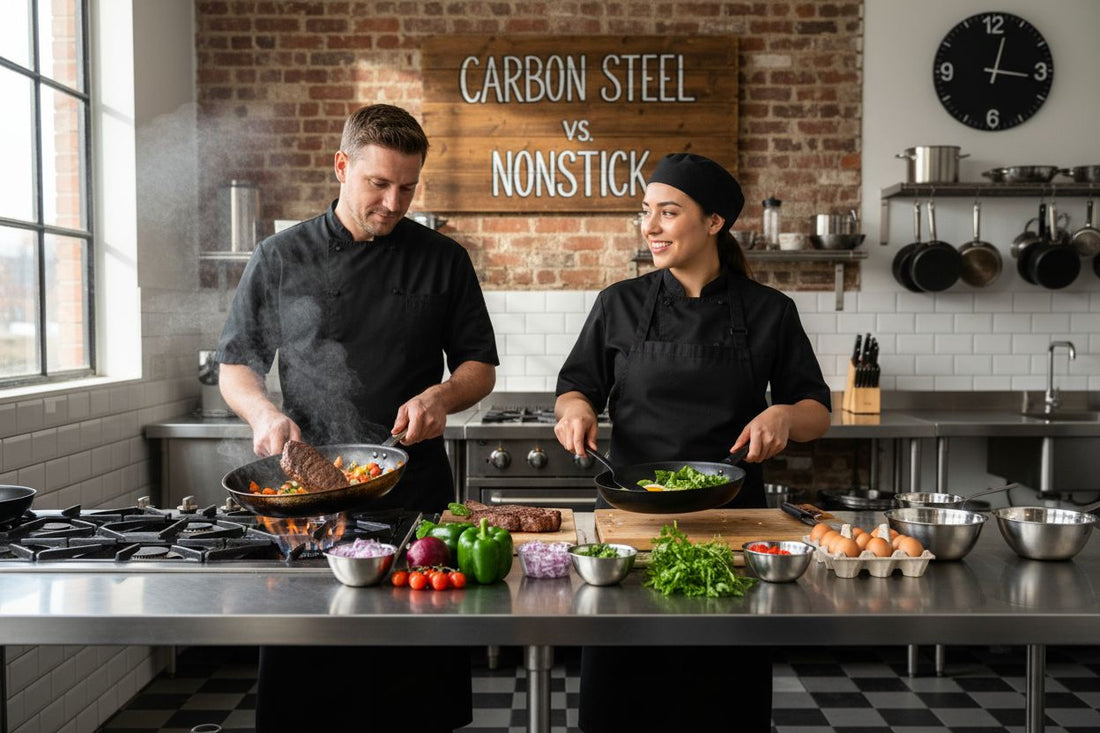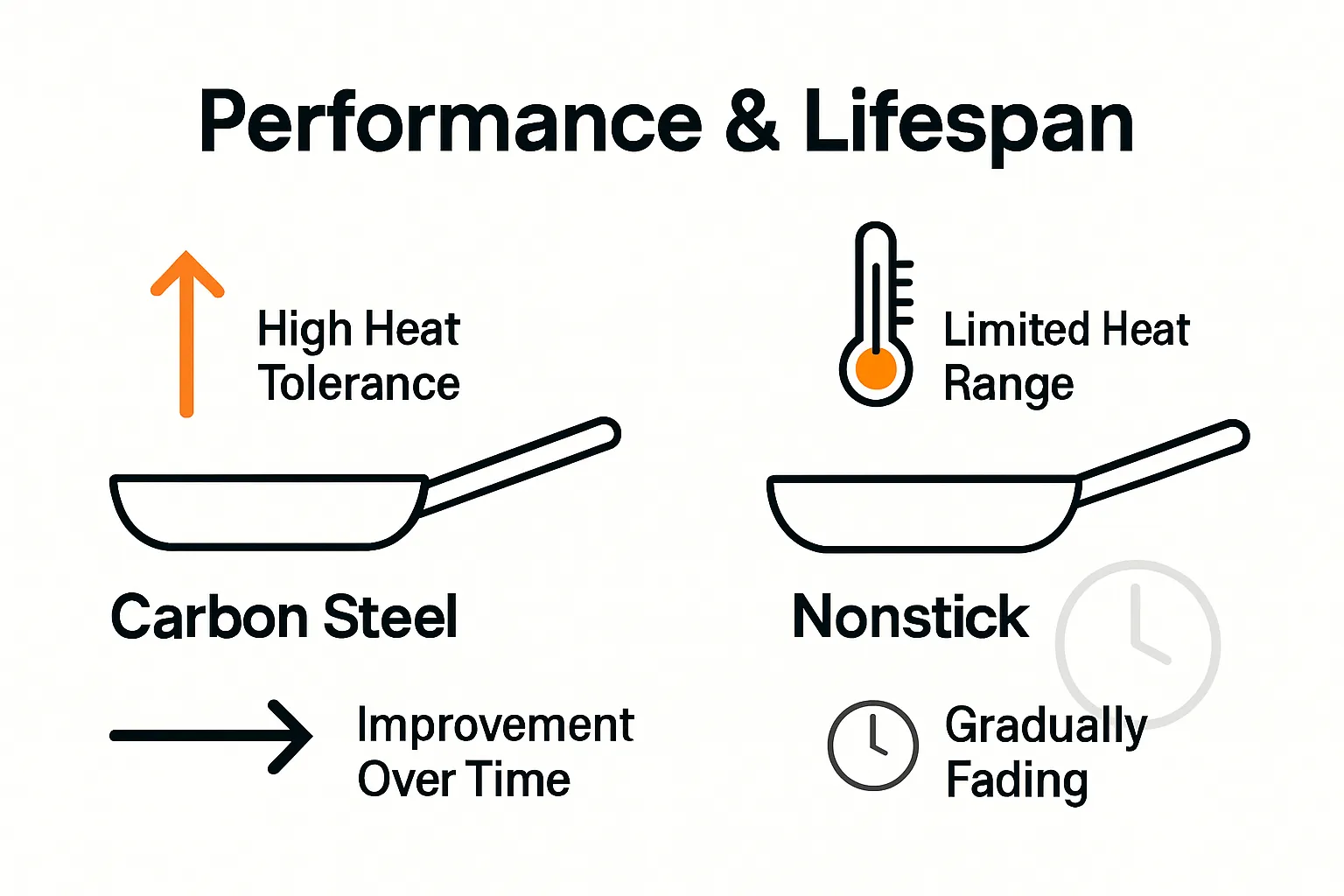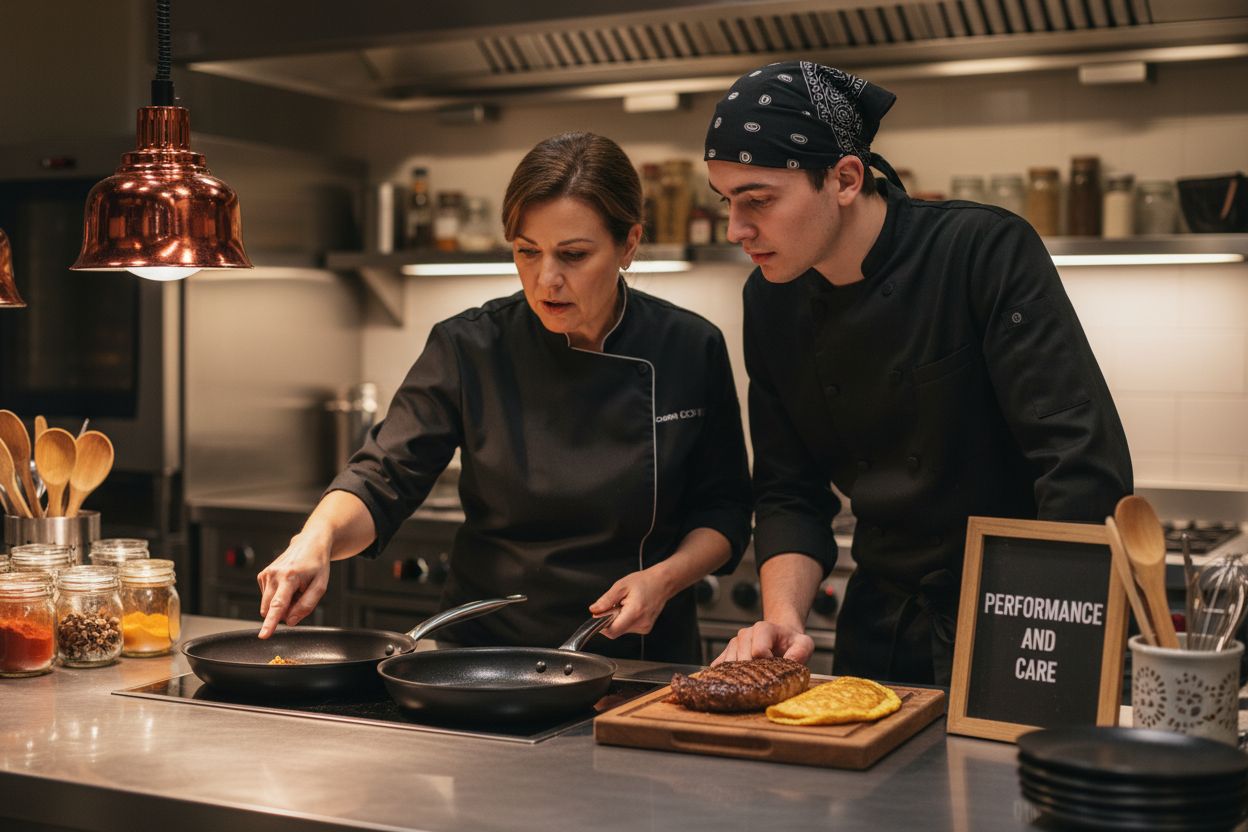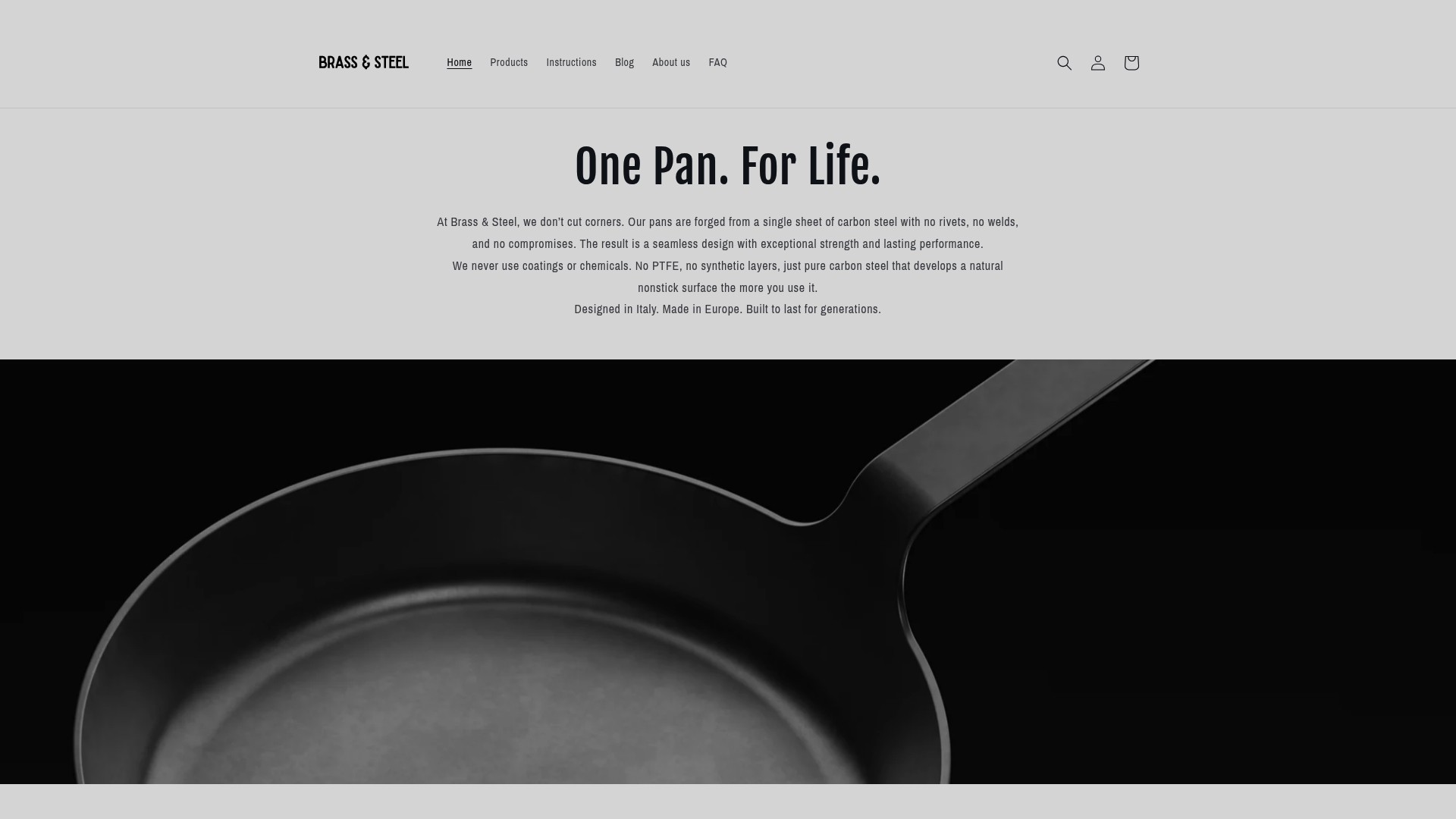
Understanding Carbon Steel vs Nonstick Comparison for Chefs
Share
Cookware shapes every meal and sets the foundation for kitchen mastery. Yet the debate between carbon steel and nonstick pans is not just about brand names or trends. Professional chefs now favour carbon steel for its ability to handle far higher temperatures than nonstick rivals and its potential to last decades with simple care. Most people reach for a nonstick pan thinking it is the convenient answer to every dish. Oddly enough, carbon steel can develop its own natural nonstick surface that actually improves with age and use.
Table of Contents
- What Is Carbon Steel And Nonstick Cookware?
- Why Choosing The Right Cookware Matters
- How Carbon Steel And Nonstick Work In Cooking
- Key Differences In Performance And Care
- Real-World Applications And Best Uses
Quick Summary
| Takeaway | Explanation |
|---|---|
| Carbon steel offers superior heat management. | Its exceptional thermal conductivity allows precise temperature control, essential for high-heat cooking techniques. |
| Nonstick cookware is ideal for delicate foods. | Designed for items like eggs and fish, it prevents sticking but struggles with high temperatures. |
| Proper seasoning enhances carbon steel’s performance. | Developing a natural nonstick surface through seasoning improves longevity and functionality with regular use. |
| Health implications vary by material. | Carbon steel is safer at high temperatures compared to nonstick surfaces, which may release harmful chemicals. |
| Choose cookware based on cooking methods. | Selecting the right material is crucial for achieving desired results across various culinary techniques. |
What is Carbon Steel and Nonstick Cookware?
Carbon steel and nonstick cookware represent two distinct approaches to cooking surfaces, each with unique characteristics and performance attributes. Understanding their fundamental properties helps chefs and home cooks make informed decisions about which cookware suits their culinary needs.
The Essence of Carbon Steel Cookware
Carbon steel is a robust metal alloy composed primarily of iron and carbon, typically containing between 0.05 to 2.1% carbon content. This composition gives carbon steel remarkable strength and heat conductivity. Professional chefs appreciate carbon steel for its incredible versatility and durability. Learn more about carbon steel pan fundamentals.
Key characteristics of carbon steel include:
- Exceptional heat responsiveness
- Natural nonstick surface when properly seasoned
- Compatible with multiple cooking surfaces
- Lightweight compared to cast iron
- Develops a unique patina over time
Understanding Nonstick Cookware
Nonstick cookware traditionally features a synthetic coating designed to prevent food from sticking during cooking. These surfaces typically use chemical compounds like polytetrafluoroethylene (PTFE) to create a smooth, low-friction cooking environment. While convenient for delicate foods like eggs and fish, nonstick pans have limitations in high-temperature cooking and durability.
The primary differences between carbon steel and nonstick cookware centre on their construction, heat tolerance, and long-term performance. Carbon steel develops a natural nonstick surface through seasoning, whereas nonstick pans rely on manufactured coatings that can degrade over time. Professional kitchens increasingly prefer carbon steel for its superior heat management and longevity.
By understanding these fundamental differences, chefs can select cookware that matches their specific cooking techniques and culinary aspirations.
Why Choosing the Right Cookware Matters
Selecting the appropriate cookware is not merely about purchasing kitchen equipment but about making strategic choices that impact cooking performance, health, and culinary outcomes. The right cookware can elevate cooking techniques, enhance flavour profiles, and ensure consistent results across various cooking methods. Explore our comprehensive guide on professional kitchen cookware selection.
Performance and Culinary Precision
Cookware acts as a critical interface between heat source and food, directly influencing cooking quality. Different materials conduct and retain heat uniquely, which means the wrong pan can lead to uneven cooking, burnt edges, or improperly prepared dishes. Professional chefs understand that cookware selection is a precision instrument in their culinary toolkit.
Key performance considerations include:
- Heat distribution capability
- Temperature responsiveness
- Weight and handling characteristics
- Durability under various cooking techniques
- Compatibility with different cooking methods
Health and Safety Implications
Beyond cooking performance, cookware material directly impacts food safety and nutritional quality. Synthetic nonstick coatings can potentially release harmful chemicals at high temperatures, while natural materials like carbon steel offer a safer, more stable cooking surface. Understanding the material composition helps chefs make informed decisions that protect both culinary quality and personal health.
Professional kitchens increasingly prioritise cookware that provides consistent performance without compromising food integrity. Carbon steel represents an excellent compromise between traditional cast iron’s durability and modern nonstick convenience, offering a naturally developing nonstick surface without synthetic chemical interventions.
By recognising cookware as an investment in cooking quality rather than a simple kitchen accessory, chefs can transform their culinary experiences and achieve more precise, enjoyable cooking results.
How Carbon Steel and Nonstick Work in Cooking
Understanding the scientific mechanisms behind carbon steel and nonstick cookware reveals why certain materials perform better in specific cooking scenarios. The interaction between cooking surface, heat, and food creates complex thermal and chemical reactions that significantly impact culinary outcomes. Learn more about different cookware material interactions.
Thermal Conductivity and Heat Management
Carbon steel and nonstick surfaces demonstrate dramatically different heat transfer characteristics. Carbon steel exhibits exceptional thermal conductivity, rapidly and evenly distributing heat across its surface. This allows for precise temperature control and quick response to cooking adjustments. The molecular structure of carbon steel enables rapid heat absorption and redistribution, creating an almost instantaneous cooking environment.
Key thermal properties include:
- Rapid heat absorption
- Uniform temperature distribution
- Low thermal lag
- High heat retention capacity
- Quick temperature adjustment
Surface Interaction and Food Release
The fundamental difference between carbon steel and nonstick cookware lies in their surface interactions. Nonstick surfaces rely on synthetic chemical coatings like polytetrafluoroethylene (PTFE) to create a smooth, low-friction interface. These coatings prevent food adhesion through their molecularly engineered slippery properties.
Carbon steel, conversely, develops a natural nonstick surface through seasoning. As oils polymerise and bond with the metal surface, they create a protective layer that becomes increasingly nonstick with repeated use. This process, known as polymerisation, transforms the cooking surface into a naturally low-stick environment without synthetic interventions.
By comprehending these intricate material properties, professional chefs can strategically select cookware that optimises cooking performance, enhances flavour development, and provides consistent culinary results across diverse cooking techniques.
Key Differences in Performance and Care
While carbon steel and nonstick cookware share the fundamental goal of cooking food effectively, their performance characteristics and maintenance requirements differ substantially. Understanding these nuanced differences enables chefs to select and maintain cookware that optimally meets their culinary requirements. Discover insights into professional cookware selection.
Temperature Tolerance and Cooking Versatility
Carbon steel demonstrates remarkable high-temperature performance, withstanding significantly higher cooking temperatures compared to traditional nonstick surfaces. Professional chefs value carbon steel for its ability to achieve intense searing and browning without compromising the pan’s structural integrity. Nonstick cookware, by contrast, has limited heat tolerance due to synthetic coatings that can degrade and release potentially harmful compounds when exposed to excessive temperatures.
Critical temperature performance factors include:
- Maximum safe cooking temperature
- Heat distribution consistency
- Thermal shock resistance
- Searing and browning capabilities
- Oven and stovetop compatibility
Maintenance and Longevity
The care requirements for carbon steel and nonstick cookware represent another significant point of differentiation. Carbon steel requires periodic seasoning to maintain its nonstick properties, a process that actually improves the pan’s performance over time. Nonstick surfaces, however, experience gradual degradation with repeated use, necessitating eventual replacement.
Carbon steel cookware offers exceptional durability when properly maintained, potentially lasting decades with appropriate care. The natural seasoning process creates a protective layer that prevents rust and enhances cooking performance. Nonstick pans, relying on manufactured coatings, typically have a more limited lifespan and require more delicate handling to prevent surface damage.

By recognising these fundamental performance and maintenance differences, culinary professionals can make informed decisions that balance immediate cooking needs with long-term kitchen equipment investments.
To clarify the practical differences and help readers compare at a glance, here is a table summarising the key differences between carbon steel and nonstick cookware based on their core characteristics, performance, and care requirements.
| Feature / Characteristic | Carbon Steel Cookware | Nonstick Cookware |
|---|---|---|
| Construction Material | Iron-carbon alloy | Typically aluminium or stainless steel with PTFE |
| Nonstick Surface | Naturally forms through seasoning | Synthetic coating (PTFE) |
| Maximum Safe Temperature | Extremely high, suitable for searing and oven use | Moderate, coating degrades at high heat |
| Durability and Longevity | Long-lasting, improves with use | Limited lifespan, coating easily degrades |
| Maintenance Requirements | Requires periodic seasoning | Gentle cleaning, avoid abrasives & metal utensils |
| Ideal Cooking Techniques | High-heat searing, caramelisation, oven-to-stovetop | Delicate foods, low-fat, eggs, fish |
| Health and Safety | Safe at high temperatures, no synthetic chemicals | Risk of chemical release if overheated |

Real-World Applications and Best Uses
Choosing between carbon steel and nonstick cookware depends on understanding their unique strengths and ideal culinary applications. Professional chefs and home cooks can optimise their cooking techniques by selecting the most appropriate cooking surface for specific dishes and techniques. Explore our comprehensive guide on professional kitchen cookware selection.
Ideal Cooking Techniques
Carbon steel excels in high-temperature cooking methods that require precise heat control and exceptional searing capabilities. Techniques like pan-searing steaks, creating crispy vegetable edges, and developing complex flavour profiles through rapid caramelisation are perfectly suited to carbon steel. The material’s rapid heat absorption and distribution allow chefs to achieve restaurant-quality browning and texture that nonstick surfaces cannot replicate.
Key cooking techniques ideal for carbon steel include:
- High-heat searing
- Rapid vegetable caramelisation
- Creating pan sauces
- Oven to stovetop transitions
- Developing complex flavour crusts
Specialised Culinary Applications
Nonstick cookware finds its niche in delicate cooking scenarios requiring minimal oil and precise food release. Egg preparations, gentle fish cooking, and low-fat cooking techniques benefit significantly from nonstick surfaces. However, these pans struggle with high-temperature techniques and cannot develop the same depth of flavour as carbon steel.
Carbon steel offers versatility across multiple cooking environments professional kitchens demand. Its durability allows seamless transitions between stovetop, oven, and even outdoor cooking surfaces. The naturally developing seasoning layer provides a progressively improving cooking surface that enhances flavour development and reduces stick potential with consistent use.
By understanding each cookware type’s strengths, culinary professionals can strategically select tools that elevate their cooking precision and expand their technical capabilities.
To support cooks in understanding which cookware best suits specific techniques, the following table outlines which cooking applications are best handled by carbon steel and nonstick pans, as discussed in the article.
| Cooking Technique | Carbon Steel Suitability | Nonstick Suitability |
|---|---|---|
| High-Heat Searing | Excellent | Poor |
| Browning & Caramelisation | Excellent | Poor |
| Delicate Egg Dishes | Good (if seasoned) | Excellent |
| Gentle Fish Cooking | Good (if well seasoned) | Excellent |
| Oven to Stovetop Transitions | Excellent | Limited |
| Low-Fat/Minimal Oil Cooking | Fair (requires seasoning) | Excellent |
| Longevity with Regular Use | Excellent | Poor |
Elevate Your Craft with Carbon Steel Expertise
Are you ready to break free from the limitations of nonstick coatings that wear out and compromise your culinary results? Discover the enduring performance and natural nonstick advantage of expertly forged carbon steel cookware. Whether you are striving for precise heat control, healthier cooking, or a pan that evolves with every use, the challenges highlighted in our comparison—such as heat tolerance, durability, and food safety—find a true solution with Brass & Steel.
Explore our Carbon Steel Collection and experience pans engineered for chefs who demand more. The single-piece construction ensures reliability, while each pan naturally develops a safe, non-toxic patina for smooth release and minimal fuss.

Ready to make the switch that professional kitchens trust? Benefit from genuine craftsmanship designed to last a lifetime and deliver superior searing, sautéing, and versatility on any cooktop—including induction. Join discerning cooks across Europe and elevate your cooking today by visiting Brass & Steel for your next heirloom-quality carbon steel pan.
Frequently Asked Questions
What is the key difference between carbon steel and nonstick cookware?
Carbon steel is a robust alloy that develops a natural nonstick surface through seasoning, while nonstick cookware uses synthetic coatings to prevent food from sticking. Carbon steel offers superior heat tolerance and longevity compared to nonstick pans.
How do I maintain carbon steel cookware?
To maintain carbon steel cookware, periodically season the pan by applying oil and heating it to create a protective nonstick layer. Proper cleaning and drying are essential to prevent rust.
Can I use metal utensils on nonstick cookware?
It’s advisable to avoid metal utensils on nonstick cookware, as they can scratch and damage the synthetic coating. Opt for silicone, wood, or plastic utensils to prolong the lifespan of your nonstick pans.
Which cooking techniques are best suited for carbon steel?
Carbon steel is ideal for high-temperature cooking techniques such as searing meats, sautéing vegetables, and creating pan sauces, where quick heat absorption and even cooking are necessary.